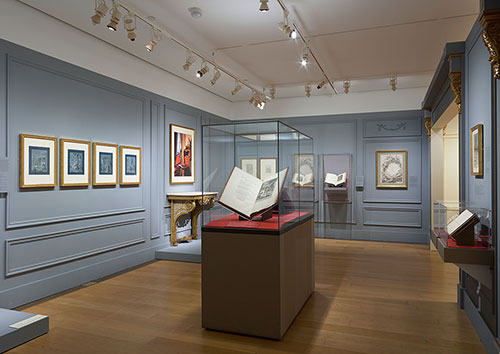The Illustrated Book
The eighteenth century was a high point in French book production, elevated by tastes and trends in printed illustration. Through the literary text, engraved illustrations, and luxury binding, a book provided its owner with three degrees of cultural prestige. The collaboration of highly trained illustrators, painters, and engravers made this an exceptional period for the visual interpretation of the literary imagination.
Engraving is an intaglio printing process in which lines incised on a metal plate are filled with ink and then impressed on paper, transferring the design. The intensity of the printed line depends on the thickness or depth of the incised groove, and in this way the engraving process is closest to drawing. Practiced in Europe since the fifteenth century, engraving was developed to an exceptional standard during the eighteenth century. The subtle shading and textures in drawings by artists like François Boucher and Jean-Baptiste Oudry could now be reproduced by skilled engravers, such as Charles-Nicolas Cochin (father and son). volumes were devoted solely to engraved illustrations recording and promoting French architecture, contemporary fashion, and court spectacle.
Boucher's Frontispiece for Macswiny

Boucher composed this sweeping allegorical frame as one of the frontispieces in Owen MacSwiny’s Tombs of Princes, Great Captains, and Other Illustrious Men, a volume of engravings featuring allegorical tombs of notable Englishmen. This composition introduced the tomb of Sidney Godolphin (1645–1712), a British politician instrumental in negotiating the Acts of Union in 1707, which established Great Britain as a political entity. Boucher’s frame was ultimately engraved by Charles-Nicolas Cochin the Younger for the print publication.
François Boucher (1703–1770)
Design for frontispiece to “Tombeau du comte Sidney Godolphin,” ca. 1735–36
Pen and black ink, and gray and brown wash, heightened with white chalk, over black chalk
Purchased as the gift of Mrs. Charles Wrightsman in honor of Mrs. Charles W. Engelhard; 1985.68
Oudry’s Fables
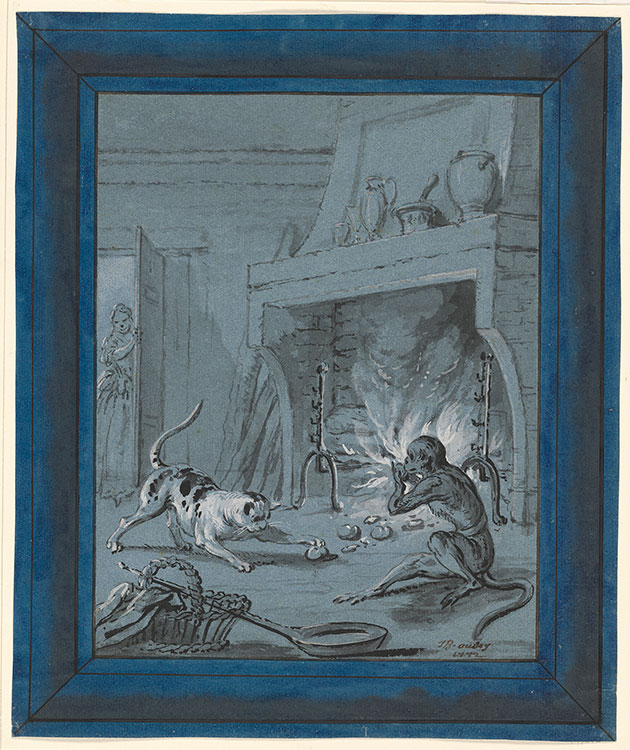



Jean-Baptiste Oudry was a portrait painter who was also well known for his ability to render animals. This is likely why he was inspired in 1729–34 to compose 277 drawings based on the animal fables of Jean de La Fontaine (1621–1695). Oudry made these compositions for his own artistic practice and enjoyment. Upon his death, however, the suite of drawings was acquired by the writer and editor Louis Regnard de Montenault (act. 1750–60), who used them to illustrate a monumental new printed edition of the Fables (in the center of the room). Montenault employed Charles-Nicolas Cochin the Younger to rework the drawings so that they could be more effectively converted into engravings.
Jean-Baptiste Oudry (1686–1755)
The Monkey and the Cat, 1732
Black ink and gray wash, with white opaque watercolor, on blue paper
The English Fox, 1733
Black ink and gray wash, with white opaque watercolor, on blue paper
The Fortune Tellers, 1733
Black ink and gray wash, with white opaque watercolor, on blue paper
Purchased on the Fellows Fund; 1976.6–8
The Man Who Runs After Fortune and the Man Who Waits in His Bed, 1731
Black ink and gray wash, with white opaque watercolor, on blue paper
Gift of Charles Ryskamp
Fabulous Fables
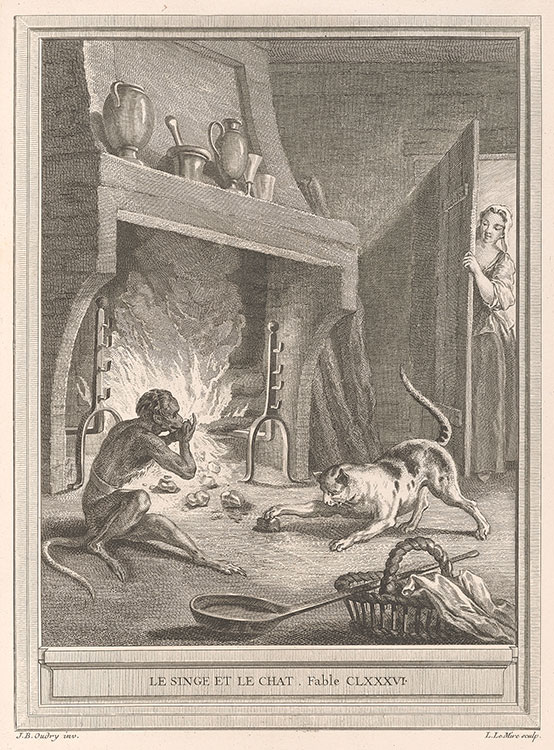
La Fontaine’s Fables is one of the most ambitious, monumental book productions to emerge from eighteenth-century Paris. A celebration of French literature, engraving, and typography, it was not so much a book to read as one to collect for its artistic value. The Monkey and the Cat illustration was engraved by Louis Legrand (1723–1807) based upon the original Jean-Baptiste Oudry and Charles-Nicolas Cochin drawing (on the wall to your left). The composition, reversed through the engraving process, has a more detailed setting and intense play of light and shadow than the original, although the focus on the lively animals is diminished.
Jean de La Fontaine (1621–1695)
Fables choisies mises en vers, 4 vols.
Paris: Chez Desaint & Saillant, and Durand, 1755–59
PML 198445–48 (PML 198447 on view)
Epic Illustration
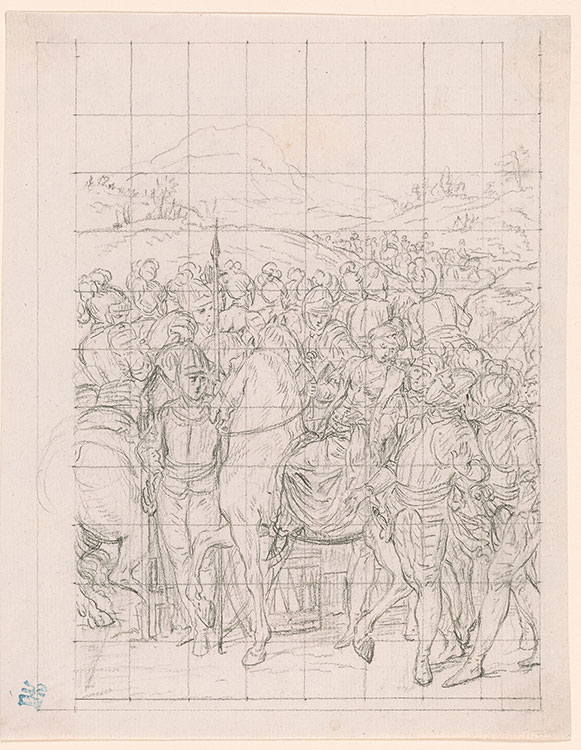
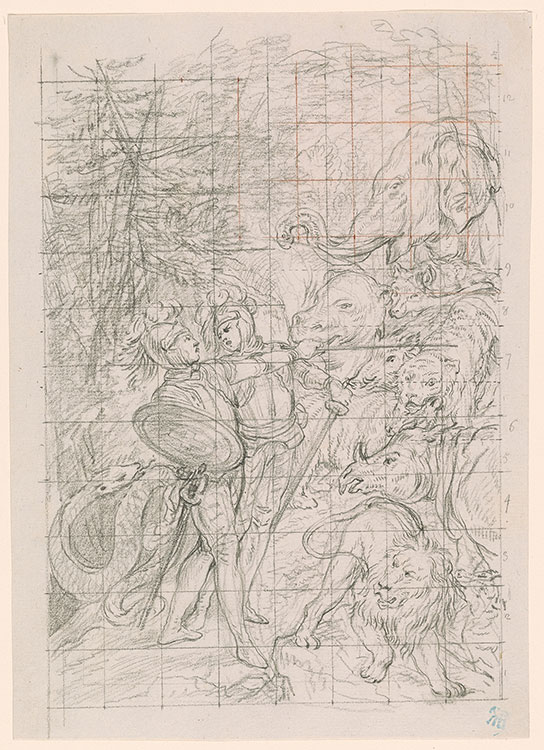
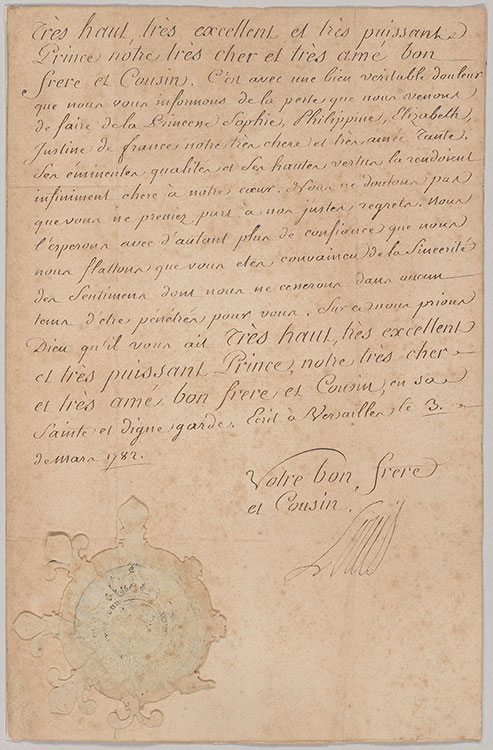
Louis Stanislas, comte de Provence, a younger brother of Louis XVI’s who later reigned as Louis XVIII, commissioned Cochin to illustrate a printed edition of the sixteenth-century epic Jerusalem Delivered by the Italian poet Torquato Tasso. Cochin produced forty-one full-page drawings and forty-one smaller head-and tailpiece illustrations, each of which earned him the considerable sum of five hundred francs. The superimposed grid on each sketch was to help enlarge and transfer the composition to a copper engraving plate. Cochin also produced more finished versions of each composition—likely to aid the engravers with details and shading—that were then gifted to Stanislas.
Charles-Nicolas Cochin the Younger (1715–1790)
Preparatory sketch for Ubaldo Driving Away the Wild Beasts with His Wand, ca. 1783–85
Black chalk on gray paper; squared in black chalk for transfer
Purchase; 1989.41:13
Preparatory sketch for Armida Departing, Leaving Behind the Crusaders as Her Prisoners, ca. 1783–85
Black chalk on gray paper; squared in black chalk for transfer
Purchase; 1989.41:5
